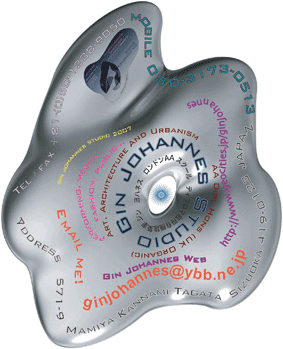
建築家 ジン・ヨハネスの『フューチャー・フルーツ・ファーム&ティールーム』
8. ハイテクの父、追悼セドリック・プライス


この本のタイトルの『Re:CP』とはレシピ、CPとはもちろんセドリック・プライスである。AAスクールから出ていたモノグラフが大分前に売り切れになった現在、彼の真価を知るにはこのタイトルだけが頼りということになる。紹介記事に載っていた彼の言葉を転記しておくが、このような言い方はなかなか出来るものではない。(英国で一般的なハイテク表現に皮肉を込めて)「テクノロジーは確かに解答なのだが、それでは設問とは一体何だったのか?」(大島哲蔵)
最近これによく似た本でタイトルは同じだが、装丁と中身が違う『Re:CP』が刊行された。元セドリック事務所のKeichiが葬式にロンドンへ行って仕入れてきたネタだ。それによると、この本の印刷が出来上がる前にセドリックは亡くなったと言うことだ。もう一冊の新刊のほうのBest Beforeつまり賞味期限が異なっていて、こちらは1 May 2006となっている。この二つの難解で曖昧な時間設定について、ことさら彼の生前のレクチャーなどで彼を知っている人であればなおさら、建築のプロジェクト或いは概念のレベルにおいてTime and Timing時間とタイミングの判断を謝るな、と豪語して自分は1時間きっかりにレクチャーを終えて葉巻きに火をつけて帰って行く姿を思い起こさせ、彼の時間概念の正確さだけが後に残っている。2冊の賞味期限付きの建築レシピは、その2つの期限の合間にセドリック本人の死と言う第3の時間期限の設定を複雑にはらみながら、今尚レシピだけが彼の仕組んだ彼自身の有効期限を表示し続けている。(ジン・ヨハネス)
Cedric Price
Hugely creative architect ahead of his time in promoting themes of lifelong learning and brownfield regeneration
Jeremy Melvin
Friday August 15, 2003
One of architecture's apparent paradoxes is that some of its most influential thinkers build very few buildings. Cedric Price, who has died aged 68, completed relatively little and never ran a large office, but his influence - through drawings, proposals, teaching and conversation - remains enormous.
It can be traced in the work of Richard Rogers and Norman Foster, Archigram (the winners of the 2002 Royal Institute of British Architects' gold medal) and even in the eastward expansion of London in the Thames Gateway. His interests anticipated the now fashionable themes of lifelong learning and brownfield regeneration.
From his 1960s designs for such structures as Joan Littlewood's Fun Palace, the Potteries Thinkbelt and Nonplan, up to and beyond Magnet in 1997, Price explored architecture's potential to nurture change, intellectual growth and social development rather than to offer a definitive aesthetic statement.
As someone particularly interested in lightweight structures and the idea that buildings should have a fixed, often short, life, it was inev- itable that he would build little during a period when buildings have increasingly been seen as solid, long lasting investments. By its very nature, his work was elusive, enticing and open-ended.
Price was born in Stone, Staffordshire, the son of the architect AJ Price, who worked on some of the great cinemas of that decade. Though he died in 1953, before his son went up to St John's College, Cambridge, to read architecture, Cedric was proud of his achievements, and delighted in referring to his technical manuals, latterly at least, as much for their value as social documents as for the quality of their advice.
In 1959, while completing his studies at the Architectural Association in London, he encountered the brilliant urban theorist Arthur Korn, an Austrian emigre whose work showed how Price's interests in indeterminacy, and suspicion of formality and convention, might contribute to remaking the built environment and the social relationships it embodied.
The following year, Price established Cedric Price Architects, and soon began producing a series of unrealised projects that catapulted him to international fame. In the Fun Palace (1961) and Potteries Thinkbelt (1964), both designed to offer innovative learning and leisure opportunities, he used architecture as the catalyst to redefine the standard relationships between people and institutions. Both were essentially short-term, fixed-life structures and enclosures giving opportunities for education, delight and fulfilment in deprived areas of east London and the pottery towns.
The architecture was indeterminate, flexible and driven by what technology then existed - and some that Price anticipated - for exchanging ideas and goods, and the movement of people from place to place. Their aesthetic of frames and gantries derived from familiar industrial architecture, rather than from the forbidding monuments of public architecture. Above all, Price and Littlewood offered a focus to the optimism of the time, when it seemed possible to remake society around the potential for delight and opportunity.
While the Interaction Centre, built in London's Kentish Town in 1971, put some of these ideas into practice on a reduced scale, Renzo Piano and Richard Rogers's Pompidou Centre would have been inconceivable without the Fun Palace.
Delight was extremely important to Price, and it gave a twist to his socialist views. Anyone prepared to treat the achievement of delight seriously was a potential friend, whether it was the flamboyant Labour MP Tom Driberg, the former Tory party treasurer Alastair MacAlpine, Princess Margaret and Lord Snowdon, with whom Price and the engineer Frank Newby designed the aviary at London Zoo, or the architect David Allford, whose most famous building was Gatwick airport.
But there was always a political element to Price's work. As he wrote of the Potteries Thinkbelt: "Education, if it is to be a continuous human service run by the community must be provided with the same lack of peculiarity as the supply of drinking water or free teeth." Architecture might help to achieve that aim by uncovering and connecting latent desires.
Nonplan, produced in 1969 with the planner Sir Peter Hall and Paul Barker, of New Society magazine, challenged the established orthodoxy of planning around established uses of land. Consistent with his belief in Pop-up Parliament, a project of 1965, Price argued that unnecessary legislation was a break on social development; planning, he believed, should switch from being "curative to preventative", setting limits rather than being didactic. It lies behind much of Hall's thinking in his contribution to the Thames Gateway.
More recent projects brought these themes to specific urban contexts. A proposal for a large site on Manhattan's west side suggested making a "lung" for the city, weaving between buildings and infrastructure. "Ducklands" looked at ways of turning redundant docks in Hamburg into bird sanctuaries, and Magnet, shown at the Architecture Foundation, proposed a series of 10 reusable structures, offering "safety, access, information, view and sanctuary" in London locations chosen for their typical urban condition of major roads, railway cuttings, parks and shopping streets.
A combination of iconoclasm and mental fecundity kept Price at the forefront of architectural debate, enthusing new generations of students and architects as he had once impressed his elders at the Cambridge Society of Arts. His ways of thinking about issues we have not yet satisfactorily resolved still resonate.
He is survived by his partner, the actor Eleanor Bron.
Cedric John Price, architect, born September 11 1934; died August 10 2003